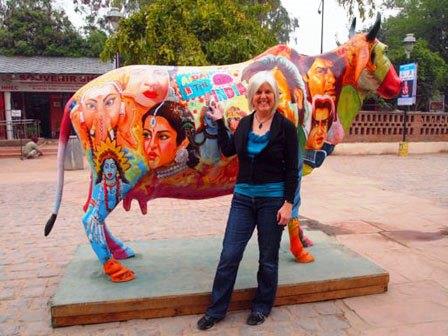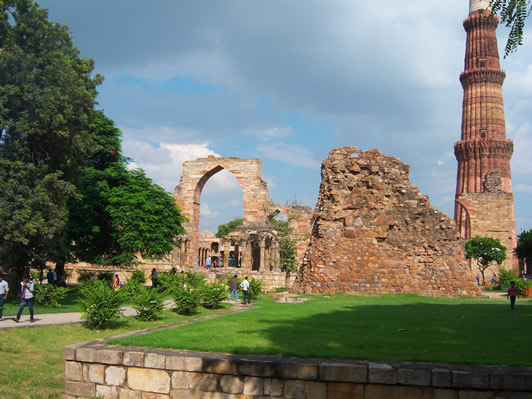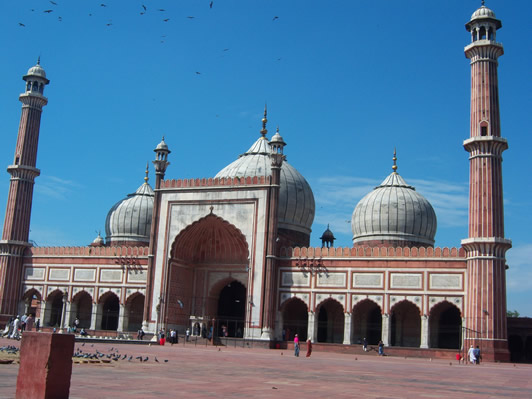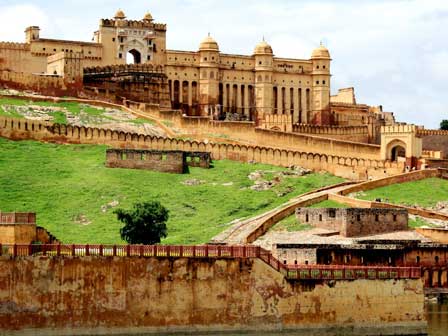
Diwali Festival Tour with Travel Astu @ $540
Diwali - The Festival of Lights:
"DIWALI" is certainly one of the biggest festivals of Hindus, Jains, Buddhists & Sikhs and is now celebrated by other communities as well. The celebration of Diwali as the "victory of good over evil" refers to the light of higher knowledge dispelling all ignorance. While the story behind Diwali and the manner of celebration of the festival differ greatly depending on the region, the essence of the festival remains the same - the celebration of life, its enjoyment and goodness. It is celebrated every year from mid-October to mid-November in many countries such as India, Singapore, Sri Lanka, Fiji, South Africa, Malaysia, Myanmar and Nepal, or where large Hindu communities are residing such as Canada, Trinidad and Tobago, Mauritius, Guyana, Australia and New Zealand.
Just as Christians believe that Christmas is an important and special holiday, Diwali for Hindus is a festival that is of great importance. Regardless of religion, you can join the Diwali festival "Festival of Lights". Diwali is undoubtedly the most important holiday in India.
| TRAVEL ASTU EXPERIENCE INCLUDES | SPECIAL HIGHLIGHTS INCLUDED |
|---|---|
| ACCOMMODATION AT MENTIONED HOTELS, | DIWALI CELEBRATIONS WITH HINDU FAMILY IN JAIPUR |
| SIGHTSEEING TOURS AS MENTIONED IN THE ITINERARY, | VILLAGE VISITS & CULTURAL INTERACTIONS, |
| PRIVATE AIR-CONDITIONED VEHICLE WITH DRIVER AT DISPOSAL, | RICKSHAW RIDE IN OLD DELHI, |
| ENGLISH SPEAKING GUIDES FOR ALL MENTIONED TOURS, | OLD CITY WALKING TOUR IN DELHI, |
| ASSISTANCE AT THE AIRPORTS/STATIONS ON ARRIVAL / DEPARTURE, | BOLLYWOOD MUSICAL SHOW WITH DINNER AT CULTURE GULLY, |
| ALL EXCURSIONS AS MENTIONED, | HORSE CART RIDE TO TAJ MAHAL IN AGRA, |
| NORMAL CLASS AIRFARE FOR JAIPUR – DELHI, | ELEPHANT RIDE AT AMBER FORT IN JAIPUR, |
| ALL MONUMENT ENTRANCE CHARGES AND DRIVER ALLOWANCES, | UNLIMITED MINERAL WATER AND TISSUES DURING DRIVES AND |
| ALL APPLICABLE TAXES, ALL ROAD TAXES, GOVERNMENT TAXE AND SERVICE CHARGES, AND | DEDICATED 24/7 TOUR MANAGER / COORDINATOR FOR TOUR. |
Day 01::
Delhi: Arrival at Delhi:
When you turn out yourself at the Indira Gandhi International Airport, a representative from Travel Astu will receive you. You will be transferred to a hotel to stretch your legs for some time.
Delhi, the capital city of magical subcontinent is located in the heart of the country and is one of the oldest cities in the world. The city has played a major role in formation of pages of history books. It is a city which has a perfect mixture of both past and present. Opulent and significance, the city is one of the irrefutable cities of the country. Basically, this city is the first port of call for those who are visiting India for the first time.
Day will be at leisure. This evening you have the option of visiting Dilli Haat to shop for traditional Indian wear and ethnic jewellery.
We will do Saree class and heena tattoo with a Indian girl.
Overnight will be at Delhi.

Dilli Haat, Delhi
Day 02::
Delhi:
After breakfast proceed for a sightseeing tour of New Delhi, which reflects the legacy of the British left behind. The division between New and Old Delhi is the division between the capitals of the British and the Mughals respectively. The division in the walled city and New Delhi also marks the division in the life-styles. The walled city is all tradition where one will be able to glean a past life-style in all its facets, colors and spells. New Delhi in contrast, is a city trying to live up to the best of 21st century standards.
Imperial Delhi will include the Qutub Minar, the tallest stone tower in India. Qutub-Minar in red and buff sandstone is the highest tower in India. It has a diameter of 14.32 m at the base and about 2.75 m on the top with a height of 72.5 m. Qutbu'd-Din Aibak laid the foundation of Minar in AD 1199 for the use of the mu'azzin (crier) to give calls for prayer and raised the first floor, to which were added three more floors by his successor and son-in-law, Shamsu'd-Din Iltutmish (AD 1211-36). All the storeys are surrounded by a projected balcony encircling the minar and supported by stone brackets, which are decorated with honeycomb design, more conspicuously in the first floor.
The tour also includes a drive past the imposing India Gate, the Parliament building and the Rashtrapathi Bhawan, the President's residence.
Visit the Lotus Temple located in south of Delhi. It is lotus shaped and has rightly been given the name. It is made of marble, cement, dolomite and sand. It is open to all faiths and is an ideal place for meditation and obtaining peace and tranquility. Its founder, Bahaullah (1817-1892), is regarded by Bahai as the most recent in the line of Messengers of God that stretches back beyond recorded time and that includes Abraham, Moses, Buddha, Zoroaster, Christ and Muhammad.
We could even have time to see the Indira Gandhi Museum or else Lotus Temple can be replaced with the museum visit. The history of the Gandhi family is well documented in this old building which was the last residence of Mrs. Gandhi.
Overnight will be at Delhi.

Qutub Minar
Day 03::
Delhi:
After breakfast at the hotel start a guided tour of Old Delhi.
The tour will begin with a visit to Raj Ghat, a simple memorial to Mahatma Gandhi. He is also famously known as the “father of the nation”.
One of the most important buildings of Old Delhi is the Red Fort. The magnificent Red Fort was built during the years 1638 – 48 when the Moghul Empire was at its peak. In 1638 Shahjahan transferred his capital from Agra to Delhi and laid the foundations of Shahjahanabad, the seventh city of Delhi. It is enclosed by a rubble stonewall, with bastions, gates and wickets at intervals. Of its fourteen gates, the important ones are the Mori, Lahori, Ajmeri, Turkman, Kashmiri and Delhi gates, some of which have already been demolished. His famous citadel, the Lal-Qila, or the Red Fort, lying at the town's northern end on the right bank or the Yamuna and south of Salimgarh, was begun in 1639 and completed after nine years. The Red Fort is different from the Agra fort and is better planned, because at its back lies the experience gained by Shahjahan at Agra, and because it was the work of one hand. It is an irregular octagon, with two long sides on the east and west, and with two main gates, one on the west and the other on the south, called Lahori and Delhi gates respectively. While the walls, gates and a few other structures in the fort are constructed of red sandstone, marble has been largely used in the palaces.
Continue your tour to Jama Masjid by bicycle rickshaws, one of Asia’s largest mosques. People stream in and out of the mosque continuously and the presence of a nearby bazaar means that the area is rarely quiet.
Enjoy the rickshaw ride at Old Delhi peddling through the narrow by lanes of Chandani Chowk.
Rest of the day will be free.
Overnight will be at Delhi.

Jama Masjid
Day 04::
Delhi – Agra: By Road 221kms in 4 hrs:
Breakfast will be at the hotel.
Visit Akshardham Temple Delhi: Akshardham means the eternal, divine abode of the supreme God, the abode of eternal values and virtues of Akshar as defined in the Vedas and Upanishads where divine bhakti, purity and peace forever pervades.
Swaminarayan Akshardham in New Delhi epitomizes 10,000 years of Indian culture in all its breathtaking grandeur, beauty, wisdom and bliss.
Proceed to Agra. Reach and check into the hotel.
AGRA: Two great Mughal monarchs, Akbar and Shah Jahan, transformed the little village of Agra into a befitting second capital of the Mughal Empire - giving it the name Dar-ul-Khilafat {seat of the Emperor}. Today a visitor to Agra is caught up in a world of contrasting edifices, of red sandstone and white marble, narrow galleys and quaint buggies, and that irresistible charm that this favorite city of the Mughals still retains. It is not surprising, that modern Agra still reflects its Mughal heritage most conspicuously.
Overnight will be at Agra.

Akshardham Temple Delhi
Day 05::
Agra:
Proceed for a Sunrise Visit of Taj Mahal.
TAJ MAHAL - Little needs to be said about this architectural wonder which is always the soul raison-de-etre for every tourist's visit to Agra. Built by Shah Jahan, the Taj is a white marble memorial to his beautiful wife Mumtaz Mahal. This monument took 22 years to be completed and was designed, and planned by Persian architect Ustad Isa. Apart from its stunning design balance and perfect symmetry, the Taj is also noted particularly for its elegant domes, intricately carved screens and some of the best inlay work ever seen.
Return to the hotel for breakfast.
Proceed for the sightseeing of Sikandra, Agra Fort and Baby Taj.
SIKANDRA – This beautifully maintained monument is where EMPEROR AKBAR was buried. It is a very low profile monument but it has one of the most awe – inspiring tombs. It is surreal how one of the greatest emperors has been put to rest. The manicured lawns has spotted and other varieties of deer roaming in them. Named after the Afghan ruler Sikander Lodi, Sikandra is the final resting place of Emperor Akbar. The Emperor began the construction of his own garden mausoleum during his lifetime. However, the construction was completed by his son Jahangir in 1613. An impressive marble - inlaid gateway leads to the spacious four - tiered monument which is crowned by a white marble cenotaph and screen. What is interesting is that the structure imbibes the best of Hindu, Christian, Islamic, Buddhist, Jain motifs, signifying the new religion started by Akbar – the DEEN E ILAHI.
AGRA FORT – The red sandstone structure is surrounded by chahar-bagh, a four-square formal garden. Built by the famed Mughal emperor Akbar in 1565 AD, the fort is predominantly of red sandstone. Ensconced within is the picture perfect Pearl Mosque, which is a major tourist attraction. It lies on the bend of the river Yamuna, almost in the heart of the town. Akbar built it as his citadel over the years 1563-73 in the finest architectural style. It has imposing gates and walls of red sandstone and a moat.
After Agra Fort we will visit BABY TAJ or the ITMAD-UD-ULLAH – The interiors of which are considered better than the Taj. One of the most beautiful Mughal tombs, Itmad-Ud-Daulah's Tomb was built by Nur Jahan, the Empress of Jahangir for her father in 1628. The tomb is a resting place of the powerful personality in Mughal Court, Itmad-Ud-Daulah, whose life is very interesting. Formerly a very poor Persian merchant then named Mirza Ghiyas or Ghiyas Beg he became a minister and a trusted treasure in Akbar's court. After Akbar's death in 1605, his son Jahangir rose into power. Jahangir made Ghiyas Beg his chief minister and honored him with the title of Itmad-Ud-Daulah, the Pillar of State. Later, Jahangir met a beautiful daughter of Ghiyas Beg named Mehr-Un-Nissa and married her. Mehr-Un-Nissa soon played a significant role in the Jahangir's court and was called Nur Mahal, the light of the Place. Owing to her influence, her father and brother were granted with privileges in the court. When Ghiyas beg (Itmad-Un-Daulah) dies in 1622, Nur Mahal decided to build a mausoleum for him. Queen Mumtaz Mahal or the lady of the Taj was also from this prevailing family. The mausoleum is entirely made of white marble and graced with intricate decoration of inlay work, and marble-screen work belonging to the Islamic style. With its tranquil, small garden on the bank of Yamuna River, the tomb stands impressively elegant from a distance.
Overnight will be at Agra.

Travel Astu Guests in Taj Mahal, Agra
Day 06::
Agra – Fatehpur Sikri - Jaipur : By Road 201kms in 5hrs:
Drive to Jaipur visiting Fatehpur Sikri en-route after breakfast.
Fatehpur Sikri is 37 km west of Agra. Jajal-ud-din-Muhammad Akbar, Humanyun's son, accessed the throne at the tender age of 14. While hunting around Sikri his curiosity was aroused by the songs of some minstrels about the celebrated Khwaja -Mu'inu'd-din Chisti, the founder of the Chisti order of SUFIS. Akbar, who was without a male heir heard about Saint Salim Chisti and visited him in the year 1568. The saint blessed him with 3 sons and in gratitude Akbar ordered the great mosque of Fatehpur Sikri built under his supervision. As a mark of respect to the saint, Akbar shifted his capital to Fatehpur Sikri and built various secular buildings like the Diwan -I-Am, Diwan-I-Khas, Jodhabai palace, Birbal's house, Marian's house and the Panchmahal.
Reach Jaipur and check into the hotel.
Jaipur is the capital of the state of Rajasthan a romantic realm of resplendent palaces, mighty fortresses and regal Maharajahs that lies in the western deserts and is an utterly unique part of India. Proudly belonging to the KSHATRIYA warrior caste and fiercely independent, the Rajput princes made fearsome foes. However, many of them realized that to maintain their wealth and authority locally, it was expedient to proclaim allegiance to the central power. Thus, many enjoyed a privileged position under the Mughal emperors and also the British Raj that followed.
This evening, visit the Birla Temple to learn more about the fascinating religious life of Jaipur. The marble structure, built as recently as 1985, houses ornate statues including one of Lakshmi (goddess of Wealth and Beauty) and Narayan dressed in gaudy robes, representing a Hindu vision of heavenly luxury. Carvings in the temple and on pillars supporting the covered walkways include images of the Hindu pantheon, as well as Jesus, the Blessed Virgin Mary and St Francis of Assisi. Your visit will coincide with the AARTI Ceremony, which involves oil lamps being lit and waved, in order to awake and invoke the deity. Enjoy the experience and spend night at Jaipur.
Enjoy the traditions and festivities of Diwali with a hindu family in Jaipur. Diwali is considered one of the world's oldest religious celebrations, a Festival of Lights that honors the Hindu god Lord Rama’s defeat of the demon king Ravana. Traditionally, Hindus illuminated their village to welcome Rama home on a moonless night. Today, local residents all over India decorate their homes with clay lamps, or diyas, on Small Diwali, then purchase new clothes, offer prayers, light fireworks, and share a plentiful feast.
Overnight will be at Jaipur.

Birla Temple, Jaipur

Diwali Festival Drawing
Day 07::
Jaipur:
Proceed for a morning excursion to Amber Fort after breakfast. Elephant ride ascent to the fort.
AMBER FORT PALACE – Amber is the classic romantic Rajasthani fort palace. Its construction was started by Man Singh I in 1592, and completed by his descendent Jai Singh I. Its forbidding exterior belies an inner paradise where a beautiful fusion of Mughal and Hindu styles finds its ultimate expression. At the foot of the hill you will mount your caparisoned elephant for the slow but steady climb up to the main gate, making your entrance in the time honored fashion. The Fort, completed in the early 18th century, took over 100 years to build and now, although deserted, offers a fascinating insight into the lifestyle of the Moghul ruling families.
Continue sightseeing.
CITY PALACE – A delightful blend of Mughal and traditional Rajasthani architecture, the City Palace sprawls over one-seventh of the area in the walled city. It houses the Chandra Mahal, Shri Govind Dev Temple and the City Palace Museum.
JANTAR MANTAR – This is the largest and the best preserved of the five observatories built by Jai Singh II in different parts of the country. This observatory consisting of outsized astronomical instruments is still in use.
HAWA MAHAL – The ornamental facade of this "Palace of Winds" is a prominent landmark in Jaipur. It is a five-storey structure of sandstone plastered pink encrusted with fine trelliswork and elaborate balconies. The palace has 953 niches and windows. Built in 1799 by Pratap Singh, the Mahal was a royal grandstand for the palace women.
In evening visit local bazar for shopping.
Overnight will be at Jaipur.

Amber Fort Palace Jaipur
Day 08::
Jaipur - Samode Village:
Breakfast will be at the hotel.
Proceed for sightseeing of a royal village SAMODE.
Samode according to the Rajputana Gazetteer of 1879 was a large and flourishing town. The Zamindars (landlords) of Samode - the principal thakurs of the state of Amber were the Nathawat clan from Chomu, a branch of the house of Amber, tracing their relation to the Jaipur Maharaja the fabled Prithviraj Singhji the 17th prince of the house of Kacchwaha Rajputs. Gopal Singhji one of his 12 sons was awarded Samode, a noble feudatory of the Amber & Jaipur principality. It was among the wealthiest territories in the Amber kingdom. The Zamindari eventually passed within the clan to the hands of Behari Das, a Rajput warrior in Mughal Service. After 6 generations in the hands of his descendants Samode was relinquished to the Raj.
The 400-year-old SAMODE PALACE has a wealth of frescoes, many of them depicting religious subjects. The highlight is a vast DURBAR HALL.
Take a walk of the Rajasthani village or take a camel cart ride.
Return to your hotel.
Overnight will be at Jaipur.

Samode Village Rajasthan
Day 09::
Jaipur – Delhi:
After breakfast proceed to Delhi
Fly back to home with sweet memories of GOLDEN TRIANGLE TOUR with Diwali Celebrations.
TOUR ENDS

